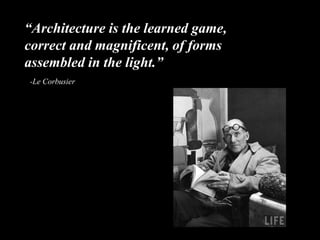Le corbusier in planning
•Télécharger en tant que PPTX, PDF•
21 j'aime•12,165 vues
Signaler
Partager
Signaler
Partager

Recommandé
Recommandé
Contenu connexe
Tendances
Tendances (20)
Garden city and the Idea of Modern Planning (Lewis Mumford)

Garden city and the Idea of Modern Planning (Lewis Mumford)
En vedette
En vedette (7)
Cours Le modernisme - style international - (Mr.Merzzag Abdelkader)

Cours Le modernisme - style international - (Mr.Merzzag Abdelkader)
Similaire à Le corbusier in planning
Similaire à Le corbusier in planning (20)
PUP 420 Theory of Urban Design Historical Perspecti.docx

PUP 420 Theory of Urban Design Historical Perspecti.docx
PUP 420 Theory of Urban Design Historical Perspecti

PUP 420 Theory of Urban Design Historical Perspecti
Urban, Historical development of urbanism, New urbanism

Urban, Historical development of urbanism, New urbanism
Plus de Gayathri Kumari
Plus de Gayathri Kumari (10)
Le corbusier in planning
- 1. “Architecture is the learned game, correct and magnificent, of forms assembled in the light.” -Le Corbusier
- 3. Modern Movement • Modernism describes a collection of cultural movements of the late nineteenth and early twentieth century • Modernism is reductive, striving towards abstraction and purity ?
- 4. Five principles of Le Corbusier
- 5. Planning concepts • Ville Contemporaine (Contemporary City) • La Ville radieuse (Radiant City) • Planned city of Chandigarh
- 6. Backgroun d • Le Corbusier (1887-1965) • One of the most prominent architects of the 20th century. • Self-proclaimed town-planner • His building designs are certainly embedded and celebrated in architectural history • His critics have been considerably less flattering in their comments on his city planning.
- 7. Ville Contemporaine (Contemporary City) • first comprehensive urban- planning • Salon d’Automne in Paris : the Contemporary City for Three Million Inhabitants
- 8. • No matter how open and green, cities should be frankly urban • Density itself is not a problem • Slums exist because of the failure to provide the proper surrounding for high density living • He protests against strict functionalism
- 9. Central city Protected Green Belt Factories and Satellite towns
- 12. • Built on the grounds where the vernacular European cities demolished • Re arranged key features of Ville Contemporine • Contain effective means of transportation • Abundance of green space and sunlight Theatres Gardens Sports Fields Squares Restaurants
- 15. Si bum apartment Seoul Korea Empire state plaza Albany
- 17. • One of the most significant urban planning experiments of the 20th century. • It is the only one of the numerous urban planning schemes of Le Corbusier to have actually been executed. • The site has some of his greatest architectural creations. • Became a symbol of planned urbanism.
- 18. • Famous for its landscaping as for its architectural ambience. Most of the buildings are in pure, cubical form, geometrically subdivided with emphasis on proportion, scale and detail • shape of the city plan is a rectangular shape with a grid iron pattern for the fast traffic roads • The city plan was conceived as post war ‘Garden City’ wherein vertical and high rise buildings were ruled out, keeping in view the socio economic-conditions and living habits of the people.
- 19. Positives and Negatives • Le Corbusier’s architectural models are well-defined and generally accepted, his urban ideas have not been so neatly packaged and disobey chronological marking out, simply because there is so much overlap • frequently blamed for the monotonous, single use zoning and car-dependent developments immediately after the Second World War. • Boring • Class based conception of life – different classes being separately housed • Doubts about the scale and degree of centralization
- 20. • Robert Hughes speaks of Le Corbusier's city planning in his series The Shock of the New "...the car would abolish the human street, and possibly the human foot. Some people would have aero planes too. The one thing no one would have is a place to bump into each other, walk the dog, strut, one of the hundred random things that people do ... being random was loathed by Le Corbusier ... its inhabitants surrender their freedom of movement to the omnipresent architect."
- 21. Thank You
Notes de l'éditeur
- Ville Radieuse (The Radiant City) is an unrealized urban masterplan by Le Corbusier, first presented in 1924 and published in a book of the same name in 1933. Designed to contain effective means of transportation, as well as an abundance of green space and sunlight, Le Corbusier’s city of the future would not only provide residents with a better lifestyle, but would contribute to creating a better society. Though radical, strict and nearly totalitarian in its order, symmetry and standardization, Le Corbusier’s proposed principles had an extensive influence on modern urban planning and led to the development of new high-density housing typologies.